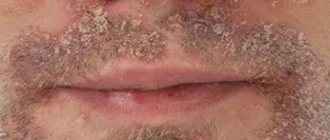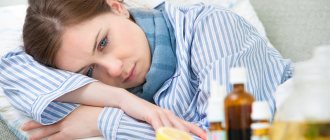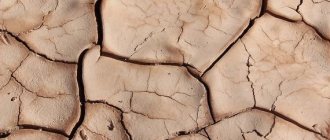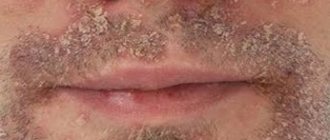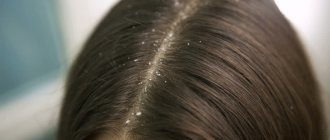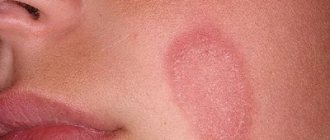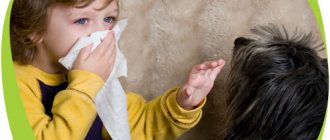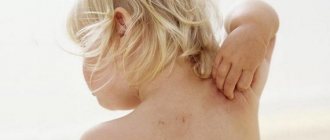Reasons for appearance
To begin successful treatment, it is important to find out the causes of symptoms. Most likely, the flakes are caused by seborrheic dermatitis. Factors influencing its development:
- puberty, hormonal disorders;
- lack of vitamins;
- dysbacteriosis;
- improper diet;
- metabolic disorders;
- overwork;
- problems with the digestive system;
- abuse of hot, spicy, fatty and salty foods.
Peeling can also be caused by stress, climate change, emotional turmoil, HIV, exposure to ultraviolet radiation, coloring compounds, and inappropriate cosmetics.
Depilation or, conversely, leaving behind excess hairs can also lead to similar troubles. The reason may lie in heredity, diseases of internal organs, or unfavorable environmental conditions.
These factors contribute to the proliferation of the fungus, which under normal conditions, living on the skin, does not have a negative effect. The rapid spread of microbes is helped by the activation of the sebaceous glands. In these cases, the skin itches and a burning sensation occurs.
Diet and nutrition rules
The disease requires a mandatory diet. It makes no difference at what stage seborrhea is. As a rule, the diet is prescribed by the attending physician. He prescribes a strict menu in which the patient may not see familiar and favorite products. Nutrition should be healthy, and nothing else. Replenishing lost energy will prevent fungi from acting as usual in a comfortable environment.
Let's look at the fundamental components of the new menu:
- Liquids – freshly squeezed juices, nectars, compotes, herbal infusions, plain water.
- Meat – dietary types of pork and beef, chicken. Sometimes rabbit or turkey meat is allowed. It is best not to fry fish, but to keep it steamed.
- Vegetable diet - pumpkin dishes, zucchini, cabbage and asparagus. Even if you don’t like seafood, you will have to “make friends” with seaweed. Other vegetables can be included in the diet on the advice of a doctor.
- Milk – it is advisable to eat milk porridge diluted with water. Oatmeal, pearl barley and buckwheat porridge should become an indispensable attribute of the table. It is recommended to consume fermented milk in the form of curd or kefir.
- Berries - immediately after picking or frozen. You can make fruit drinks from the berries. Special mention should be made of berries such as gooseberries, currants, cherries and watermelon (this is also a berry). Limit your consumption of sweet jam, or better yet, eliminate it from your diet altogether.
In addition to dietary permitted foods, you should be aware of prohibited foods. Let's try to figure out what you will have to say goodbye to during treatment for seborrheic dermatitis:
- dishes prepared by frying;
- fatty foods;
- pickled vegetables;
- smoked and pickled foods;
- products of fast food establishments (McDonald's);
- fish caviar (red and black);
- sour fruits (citruses);
- mushrooms in any form.
Where to start treatment
When symptoms appear, you should pay increased attention to hygiene, nutrition, daily routine and immunity. Sometimes proper care can solve the problem without contacting a specialist. However, you should not delay going to the doctor. If you feel that your efforts are not bringing improvement, go to a dermatologist.
The doctor will prescribe an examination that will help identify the source of dandruff in the eyebrows. If it turns out that there are no skin problems, then the second specialist who should be visited is a gastroenterologist. He will begin to examine the internal organs.
If the gastrointestinal tract system is working normally, a consultation with a therapist is necessary, who, if necessary, will refer you to a neurologist, gynecologist, immunologist or endocrinologist.
Types of dandruff
Dry dandruff
– caused by decreased sebum secretion (too dry skin). In this case, dandruff flakes are small in size, easily come off the skin, and a “powdered” effect is observed on the hair. Most often they are located along the entire length of the hair; lesions form quite rarely.
Oily dandruff
– this disorder occurs with increased sebum secretion. Dandruff flakes are large, stick together and attach to the hair. They peel off more easily than dry ones. With such dandruff, the hair quickly becomes oily and the patient feels constant itching.
Traditional methods of combating peeling
The problem of dandruff that forms in the eyebrows has long been known, so in folk medicine there are many recipes to combat the disease. In particular, it is proposed to use:
- Vaseline, linseed, castor, camphor oils;
- tea tree oil, which is famous for its antiseptic properties;
- baby creams;
- herbal infusions with St. John's wort, string, aralia, burdock - it is suggested to drink infusions or wipe the affected areas with them.
Traditional methods of treatment should be treated with caution. What is good for nourishing healthy skin is not always good for peeling and inflammation. Be sure to consult your doctor.
Reception is strictly by appointment only!!!
Doctor Plus LLC License No. LO-77-01-004801
Dermatologist services in the clinic
Make an appointment at the clinic
- +7 (495) 125-49-50
- Addresses of clinics in Moscow
- Daily
- call me back
Rashes on the eyebrows are quite common and can be observed in people of different genders and ages. The appearance of acne in such a part of the face can also be a sign of diseases that require treatment.
The appearance of acne on any part of the face can upset anyone, because they noticeably spoil the appearance. Most consider this to be a purely cosmetic problem, however, the localization of rashes in certain areas of the body can indicate disorders occurring in the body.
Prevention
To avoid dandruff in the eyebrows, you don’t have to look for the causes of the problem and methods of treatment; it is better to take preventive measures in time.
What does it include?
- Proper skin care. Washing gels, lotions, creams, peelings and other products should be selected according to your skin type.
- Acupressure using oils and creams.
- Using masks and essences to strengthen eyebrow hairs.
- Combing eyebrows along the growth line with special brushes.
- Visit to a cosmetologist.
Prevention methods, thanks to which you will never need treatment for dandruff on your eyebrows, also include maintaining a sleep schedule and proper nutrition, giving up bad habits and drinking enough water, and timely treatment of infectious and other diseases.
Treatment of total alopecia Alopecia, or baldness, is quite common in men, but it also occurs in women and children. There are several types - focal, nested, diffuse, scar, non-scar. The most severe form is considered to be total alopecia, which leads to complete hair loss. It progresses gradually, appearing first in small areas, and over time affecting more and more areas. The intensity of the flow can vary from two to three months to a year or longer. Hair loss due to stress The statement that all diseases are caused by nerves is not unfounded. Against the background of emotional stress, chemical processes occur in the body that negatively affect health. Caring for porous hair Why do some people have curls that shine in the sun, flutter beautifully in the wind and look like they came out of a salon procedure, while others don’t even with regular care? It's all about porosity. Baldness in the temples and back of the head in men In most cases, baldness in men begins in the temple area - the hair becomes short, vellus and sparse. If you contact a trichologist at this stage, you can stop the progression of alopecia and restore aesthetics. Causes of hair loss on the back of the head Modern research methods make it possible to most accurately determine the cause of baldness on the back of the head in men, assess the current condition of the hair and scalp, and select home care. Treatment of androgenetic alopecia in men Every hair on our body grows from a follicle - the shell of the hair follicle, consisting of epithelium, sebaceous and sweat glands, blood vessels and nerve endings.
What not to do?
Absolutely forbidden:
- Scratch your head. Itchy dandruff can be very uncomfortable, but scratching and scratching your skin will make the problem worse. Through the slightest damage, infections can easily penetrate, which can lead to the formation of pustules;
- Use alcohol-based products, as they greatly dry out the skin;
- Dye your hair and use other chemical hair products;
- Use metal combs; the teeth of such a comb can damage the scalp and cause more dandruff to appear.
- Keep the use of hair dryers and curling irons to a minimum.
Symptoms of seborrhea
Dandruff on eyebrows has the following symptoms:
- Dandruff on the eyebrows can appear and disappear on its own.
white plaque (scales) on the eyes, eyebrows, temple area; - redness of the skin;
- itching;
- the appearance of crusts on the wounded areas.
In many cases, brow seborrhea appears and disappears unnoticed. In children and adults, it can be asymptomatic and spontaneous. It is impossible to determine the causes of dandruff above the eyebrows solely by symptoms. Cure of this disease is mandatory since its manifestations are a signal of the presence of diseases. The manifestation of seborrhea depends on the individual characteristics of the body.
Features of the disease
Dandruff doesn't just affect your appearance; it's a sign of health problems. Most often, dandruff appears as a result of a decrease in the body’s protective functions, relapses of chronic pathologies, and metabolic disorders.
Dandruff mainly affects the scalp, but sometimes appears on the eyebrows. In this case, peeling occurs, which is accompanied by burning and itching, and scales appear.
Important!
The main cause of dandruff is considered to be a malfunction of the sebaceous glands or pathological proliferation of fungi.
Fungi always exist on the epidermis, but they are in a latent state. When the immune system is normal, they do not manifest themselves in any way.
But, if its operation malfunctions and increased sebum production occurs, the fungal infection begins to activate and multiply quickly. This is what causes seborrhea.
What to do if your eyebrow itches?
Often, under the influence of external and internal factors, the nerve endings in the skin under or near the eyebrow are irritated, which causes unbearable itching. It leads to scratching, redness, swelling, and hair loss. If the eyebrow itches, treatment should be prescribed by a dermatologist - this problem is under his jurisdiction.
Symptoms
- Itching above the eyebrows indicates a fungal infection, poor diet, and dandruff;
- under the eyebrows - demodicosis, allergy to cosmetics;
- between the eyebrows - insect bite, allergy, microtrauma;
- if eyelashes or eyes itch along with the eyebrows, this is blepharitis or demodicosis (treatment should be prescribed by an ophthalmologist);
- simultaneous itching of the eyelids - a reaction to cosmetics;
- nose - runny nose, allergies, oily skin type;
- forehead - seborrhea, fungal disease;
- if the eyebrows not only itch, but also peel, it’s an allergy or a fungus;
- fall out - a malfunction of the body (a medical examination is necessary);
- red - due to an insect bite, minor injury, allergic reaction, severe scratching.
Causes
- Tattoos, permanent makeup, microblading, dyeing or henna;
- onset of skin diseases: seborrhea, psoriasis, fungus, demodicosis, infections;
- mental disorders: constant stress, emotional burnout, nervous breakdown, depression;
- oncology;
- circulatory pathologies;
- problems with the gastrointestinal tract: disorders, poisoning, intoxication, increased acidity, gastritis;
- allergy;
- in summer - ultraviolet radiation and salty sea water;
- overdose of nicotine and alcohol;
- dry air;
- poor nutrition;
- insect bites.
Everyone is familiar with the unpleasant sensation when the eyebrow begins to twitch, radiating into the upper eyelid. Rhythmically pulsating “shots” interfere with concentration and cause a lot of discomfort, especially if they do not end for a long time. It turns out that this is not just a muscle contraction that can be endured and then safely forgotten. A nervous tic in this area of the face can mean serious health problems. And it requires medical diagnosis and treatment.
Causes
- Injuries to the brain, face;
- herpes;
- meningitis;
- increased intracranial pressure;
- circulatory disorders;
- concussion;
- decreased immunity;
- allergy;
- tumor;
- avitaminosis;
- blepharitis, conjunctivitis;
- post-stroke or pre-infarction condition;
- psychological problems: depression, chronic fatigue, neurosis, anxiety, stress, overwork, nervous exhaustion, postpartum weakness, emotional breakdown.
What to do?
- Go to bed or at least close your eyes for 5-10 minutes;
- blink quickly;
- make a compress from a tea bag;
- perform a breathing exercise;
- drink warm, relaxing tea;
- massage the eyebrows and eyelids.
Diagnosis of the disease
It is impossible to prescribe a course of treatment without appropriate diagnostic procedures. The doctor must see the full picture of the disease, as well as a medical record with a medical history and the possibility of a hereditary factor. Initially, a visual examination and interview of the patient is carried out. At this stage, the person’s well-being, the period of onset of symptoms, and the patient’s lifestyle are determined. After this, additional tests are prescribed. A scraping of the affected area is taken, the type of fungus and the development of pathology are examined. It may be necessary to test the patient's blood and urine to identify problems with internal organs that can cause dandruff.
